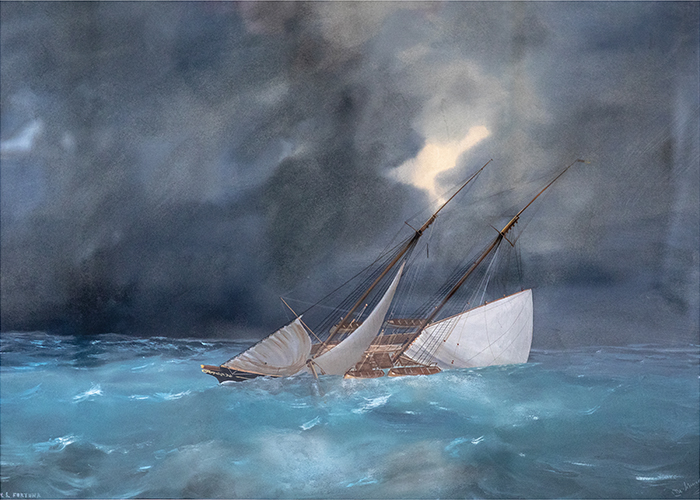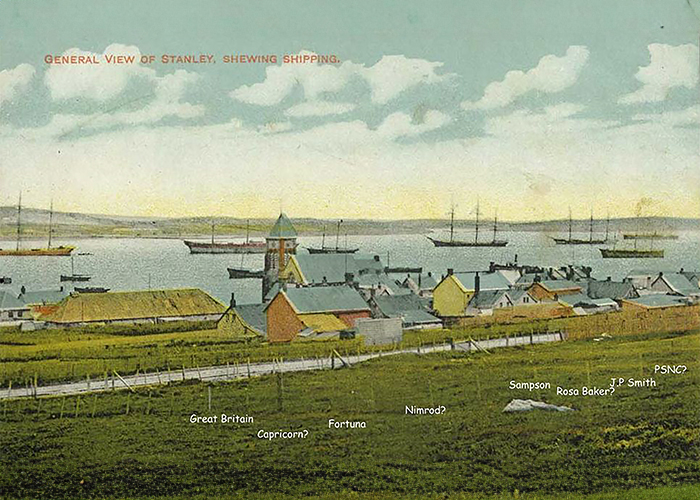The schooner Fortuna was built in our Lymington shipyard, then owned by G. Inman, in 1876/77 for Mr Adrian E. Hope of 8 Chesterfield Gardens, London, a Royal Yacht Squadron member. She was registered in Southampton and her captain until 1886 was Oliver Andrews residing at 36 High Street, Lymington.
 Schooner FORTUNA being built at Lymington shipyard 1876, Shipyard House showing behind her.
Schooner FORTUNA being built at Lymington shipyard 1876, Shipyard House showing behind her.
She was of 192 registered tons (366 Thames measurement), 130 feet in length, beam of 25 feet, draft of 13 feet, and fitted out with Lapthorn sails. During the ownership of Adrian Hope she did many cruises around Great Britain and the Mediterranean. From the paintings of marine artist Tomasso de Simone in 1886 we learn that she was dismasted and damaged in a gale at Shanklin Bay, Isle of Wight. It would appear from the records that Mr Hope sold her in 1891.

FORTUNA reefed down in a gale off the coast of the Isle of Wight

The dismasted Fortuna limping into Shanklin Bay off the coast of the Isle of Wight

Lifeboat coming alongside; and the crew of the FORTUNA being rowed to shore
In 1893 she was offered for sale again for £2,000 and this is where her new life begins.
Captain Francis Rylander (anglicised to Rowlands), a Swede, was shipwrecked in 1860, and became resident in the Falkland Islands, becoming known to all his new friends as the Commodore. In 1881 he travelled to Portsmouth to buy his own ship and purchased the ex RYS schooner Fair Rosamond and sailed her back to the Falklands for coastal service and voyages to Magellan straits in southern Chile. He was then induced by the Falkland Islands Company to take command of their newly purchased ex RYS schooner Castalia also previously built for Mr Adrian E. Hope in 1874. This vessel was damaged in an overnight gale whilst at anchor in Gull Harbour, Weddell Island in March 1893 and the Falkland Islands Company was in need of a replacement. Captain Rowlands brought his sick wife back to her family in Dumfries in August 1893, and he found Fortuna for sale. An ideal vessel for Falkland coastal service and voyages to South America, she was purchased by the Falkland Islands Company and refitted in Gosport for her new service, which would involve carrying passengers and stores to remote farms and islands along with bales of wool and livestock. She was re-rated at 164 tons.
Adrian Elias Hope 1845-1919 – Owner of the FORTUNA 1876-1891
Fortuna sailed from Gosport on St Valentine’s day 1894 with a full cargo for Packe Brothers, Dunnose Head Ranch, West Falklands and had a fast passage of 49 days and 12 hours on the 8,000 mile voyage. She sailed remarkably well, overtaking every sailing ship they met and the best day’s run was 276 miles. This was an exceptionally fast voyage time, having beaten Fair Rosamond’s by 13 days. On the 33rd day at 29 10 south, 15 03 west, she passed the four-masted Seafarer of Liverpool which was at the time 50 days into her voyage from Gravesend around Cape Horn to San Francisco. On arrival in Port Stanley, the Falkland Islands Company manager Mr W.A. Harding described Fortuna as the finest schooner ever to come to the islands.
FORTUNA at Gosport in Portsmouth Harbour February 1894 ready to sail to Falkland Islands
Due to her size, speed and sea keeping qualities, she was popular with passengers. Fortuna sailed successfully around the Islands under Rowlands’ command for nine years. In August 1903, she was sailed to Montevideo for refit, the 1,000-mile voyage made in very heavy weather, and some of her sails blown out, but the distance was covered in 9 days. A telegram was sent to England asking for new sails to be dispatched by the next mail steamer to Uruguay. Fortuna arrived back in Port Stanley looking clean and trim on 6th November ready for further service. But by then, steam ships had taken over most of the long-distance voyages to Montevideo and the Magellan Straits, so she was just used for local island traffic and cargo.
Captain F. T. Rowlands 1835-1919
In July 1905 the Danish sailing vessel Sixtus under Captain Eriksen was wrecked on Volunteer Point and her crew was rescued by Fortuna. In September it was Fortuna to the rescue again when the Kirkhill under Captain Howell journeying from South Shields to San Francisco with a cargo of coke and pig iron struck the Wolf Rocks off the Falkland coast and sank in six minutes: all the crew were saved.
FORTUNA deck with Captain Rowlands
In October 1905 a formal Falkland Government Gazette Notice was issued and advert placed in the Newspaper, offering a reward of £50 for “information which would lead to conviction of the person or persons who had maliciously attempted to set fire to the schooner FORTUNA in Port Stanley on 20th September”.
FORTUNA anchored in the Falkland Islands – Gosport, England to Dunnose Head, Falkland Islands in 49 days – 1894

After a 30 years of sailing, Fortuna’s good fortune came to an end. In May 1906, she had departed Port Stanley to collect ranch owners for the next mail steamer calling northbound from Valparaiso. Having collected the Bonner family from San Carlos, she sailed down Falkland Sound between the two main islands in the dark, at 19.30 hours sailing near West Island. Close to her destination port of Fox Bay, she grounded on a reef. A kedge anchor was put out in endeavour to haul her off, but this failed. Landing in the dark was impossible so the boats were kept alongside, bumping all night causing anxiety to all, passengers with children in their arms were kept on the steps of the stairs ready for a moments notice to go on deck. When daylight arrived passengers were put ashore on the island and sheltered in the high tussac grass from the bitterly cold east wind. A tent was made with oars and sails, and clothing and luggage were rescued. Nothing could be done for Fortuna and she filled with water. After two days on the island, schooner Lafonia (ex- Liverpool pilot schooner George Holt) was passing and rescued them. Lafonia’s voyage on to Port Stanley was then delayed with bad weather, but it was the passengers’ luck that the mail steamers’ arrival was also late and the onward connection was made. The steam tug Samson was sent out, but nothing could be done to salvage Fortuna.
Captain Rowlands went on to command another ex RYS schooner Gwendolin, purchased as Fortuna’s replacement, until his retirement in his late seventies.
In recent years paintings of Fortuna, and the original dinner service crockery from the schooner, have been offered for sale in England.



